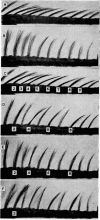Abstract
It has been shown by others that hemicholinium (α,α'-dimethylethanolamino-4,4'-biacetophenone) inhibits the synthesis of acetylcholine, an effect which is reversed by choline. Hemicholinium produces a failure of response to nerve stimulation in the following sympathetically innervated preparations: guinea-pig isolated vas deferens, rabbit isolated uterus, rabbit isolated colon, perfused rabbit ear, cat isolated atria and the piloerector muscles in the cat's tail. The blocking action of hemicholinium on the responses to postganglionic sympathetic stimulation resembles its blocking action against cholinergic nerve stimulation observed on rabbit isolated atria with vagus nerves, rabbit isolated vagina with pelvic nerves, and guinea-pig isolated diaphragm with phrenic nerve. The failure of transmission produced by hemicholinium in sympathetic nerves and in cholinergic nerves can be reversed by choline. It is suggested that if there were a cholinergic junction at sympathetic nerve endings the mechanism of the blocking action of hemicholinium at these endings could be explained by inhibition of acetylcholine synthesis.
Full text
PDF












Images in this article
Selected References
These references are in PubMed. This may not be the complete list of references from this article.
- BIRKS R. I., MACINTOSH F. C. Acetylcholine metabolism at nerve-endings. Br Med Bull. 1957 Sep;13(3):157–161. doi: 10.1093/oxfordjournals.bmb.a069605. [DOI] [PubMed] [Google Scholar]
- BIRKS R. I., MACINTOSH F. C., SASTRY P. B. Pharmacological inhibition of acetylcholine synthesis. Nature. 1956 Nov 24;178(4543):1181–1181. doi: 10.1038/1781181a0. [DOI] [PubMed] [Google Scholar]
- BURN J. H., LEACH E. H., RAND M. J., THOMPSON J. W. Peripheral effects of nicotine and acetylcholine resembling those of sympathetic stimulation. J Physiol. 1959 Oct;148:332–352. doi: 10.1113/jphysiol.1959.sp006291. [DOI] [PMC free article] [PubMed] [Google Scholar]
- Bülbring E., Burn J. H. The sympathetic dilator fibres in the muscles of the cat and dog. J Physiol. 1935 Mar 15;83(4):483–501. doi: 10.1113/jphysiol.1935.sp003246. [DOI] [PMC free article] [PubMed] [Google Scholar]
- Finkleman B. On the nature of inhibition in the intestine. J Physiol. 1930 Sep 18;70(2):145–157. doi: 10.1113/jphysiol.1930.sp002683. [DOI] [PMC free article] [PubMed] [Google Scholar]
- GESLER R. M., HOPPE J. O. Observations of the neuromuscular blocking activity of a series of bis-quaternary pyridazines, with particular reference to the effects of frequency of stimulation. J Pharmacol Exp Ther. 1956 Dec;118(4):388–394. [PubMed] [Google Scholar]
- Gaddum J. H., Kwiatkowski H. The action of ephedrine. J Physiol. 1938 Oct 14;94(1):87–100. doi: 10.1113/jphysiol.1938.sp003664. [DOI] [PMC free article] [PubMed] [Google Scholar]
- KOTTEGODA S. R. The action of nicotine and acetylcholine on the vessels of the rabbit's ear. Br J Pharmacol Chemother. 1953 Jun;8(2):156–161. doi: 10.1111/j.1476-5381.1953.tb00770.x. [DOI] [PMC free article] [PubMed] [Google Scholar]
- MCEWEN L. M. The effect on the isolated rabbit heart of vagal stimulation and its modification by cocaine, hexamethonium and ouabain. J Physiol. 1956 Mar 28;131(3):678–689. doi: 10.1113/jphysiol.1956.sp005493. [DOI] [PMC free article] [PubMed] [Google Scholar]
- NASMYTH P. A., ANDREWS W. H. The antagonism of cocaine to the action of choline 2,6-xylyl ether bromide at sympathetic nerve endings. Br J Pharmacol Chemother. 1959 Dec;14:477–483. doi: 10.1111/j.1476-5381.1959.tb00951.x. [DOI] [PMC free article] [PubMed] [Google Scholar]
- PATON W. D. M. The paralysis of autonomic ganglia, with special reference to the therapeutic effect of ganglion-blocking drugs. Br Med J. 1951 Apr 14;1(4710):773–778. doi: 10.1136/bmj.1.4710.773. [DOI] [PMC free article] [PubMed] [Google Scholar]
- PATON W. D. M., ZAIMIS E. J. Paralysis of autonomic ganglia by methonium salts. Br J Pharmacol Chemother. 1951 Mar;6(1):155–168. doi: 10.1111/j.1476-5381.1951.tb00631.x. [DOI] [PMC free article] [PubMed] [Google Scholar]
- PRESTON J. B., VAN MAANEN E. F. Effects of frequency of stimulation on the paralyzing dose of neuromuscular blocking agents. J Pharmacol Exp Ther. 1953 Feb;107(2):165–171. [PubMed] [Google Scholar]
- REITZEL N. L., LONG J. P. Hemicholinium antagonism by choline analogues. J Pharmacol Exp Ther. 1959 Sep;127:15–21. [PubMed] [Google Scholar]
- SCHUELER F. W. A new group of respiratory paralyzants. I. The "hemicholiniums". J Pharmacol Exp Ther. 1955 Oct;115(2):127–143. [PubMed] [Google Scholar]
- VARAGIC V. An isolated rabbit hypogastric-nerve-uterus preparation, with observations on the hypogastric transmitter. J Physiol. 1956 Apr 27;132(1):92–99. doi: 10.1113/jphysiol.1956.sp005504. [DOI] [PMC free article] [PubMed] [Google Scholar]
- WILSON H., LONG J. P. The effect of hemicholinium (HC-3) at various peripheral cholinergic transmitting sites. Arch Int Pharmacodyn Ther. 1959 Jul 1;120:343–352. [PubMed] [Google Scholar]




